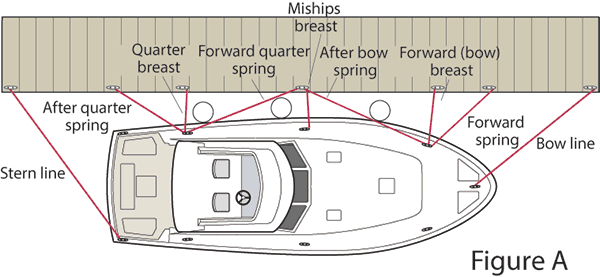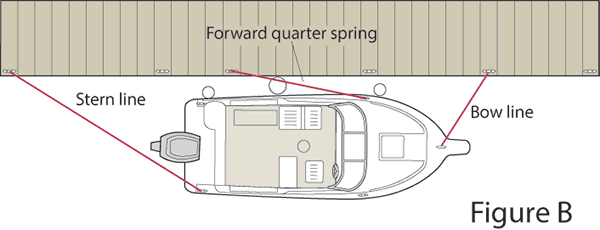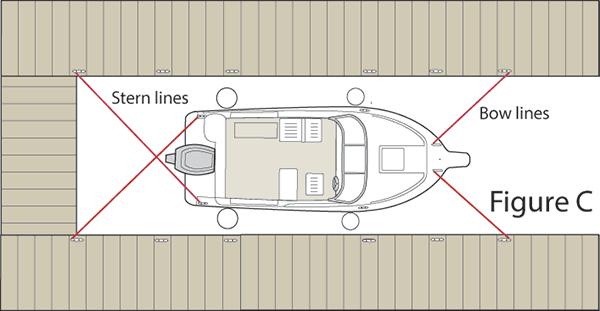Docklines — Tying Up Alongside
Docklines limit a boat’s motion. That motion can be either in a fore-and-aft direction or a transverse direction — or a combination of the two. The key is to identify the fewest number of docklines that will limit the boat’s motion in every direction. Breast lines (lines that come off the boat at a right angle to it) limit how much the boat can move toward or away from the dock. Springlines (lines that run at a shallow angle along some portion of the length of the boat) limit how much the boat can move forward or backward. Bow lines and stern lines (lines from the bow forward to the dock or from the stern aft to the dock) may do some of each.

A Glossary of all Possible Lines
Figure A shows virtually all the possible docklines you could use — but hopefully not all at once! Docklines are named according to this convention: [direction from boat] [position on boat] [line’s function]. So, a “forward quarter spring” is a line that runs forward to the dock from the cleat at the boat’s stern quarter; it prevents the boat from moving astern. An “after spring” is a dockline that leads aft; it limits the boat’s forward motion.

When Tying Up the Goal is to Use Only the Ones Needed to Safely Secure the Boat
For a short stop alongside a dock, you should be able to tie up with just three lines (Figure B). Breast lines have a disadvantage in places with tidal ranges or even wakes from passing boats: being so short, they limit a boat’s vertical motion. Even stepping on the gunwale to get out of a small boat may strain a breast line. The best combination of docklines is typically at least one springline, plus a bow line and a stern line. If you run the bow line forward and the springline aft, you’ll limit the boat’s motion in both directions yet still allow for some motion up and down. Likewise, run the stern line aft from the side of the boat farthest from the dock. This will limit both transverse and forward motion. Place good fenders between the boat and the dock, then tension up the lines. For heavier weather and longer stays, add a second springline in the opposite direction of the first.
Docklines — Tying Up In A Slip

Docklines Illustration Tying Up with Only Four Lines
Tying up in a slip typically works best with four docklines: two bow lines, and two stern lines (Figure C). As for leaving room for the water to move up and down, the same caveats still apply. Try to avoid breast lines. Instead, run your bow lines forward a bit and cross your stern lines. This way, all the lines are working together to limit motion forward, aft, and side to side. If your boat is over 35 feet or you expect lots of wind or current, add a set of spring lines.


